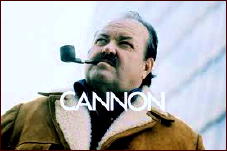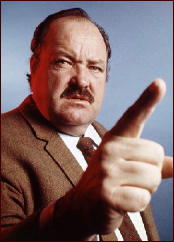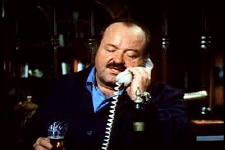Mon 6 Feb 2012
A TV Review by Mike Tooney: CANNON “The Proxy” (1973).
Posted by Steve under Reviews , TV mysteries[11] Comments

“Murder by Proxy.” An episode of Cannon (1971-76). Season 3, Episode 5. First broadcast: October 10, 1973. William Conrad (Frank Cannon), Anne Francis (Peggy Angel), Linden Chiles (Ray Younger), Marj Dusay (Mrs. Farrell), Charles Bateman (Lt. Paul Tarcher), Ross Hagen (Wendell Davis), Charles Seel (apartment house manager), James Nolan (Sparks Foster), Jack Gaynor (man). Writer: Robert W. Lenski. Director: Robert Douglas.
There was a time when many, perhaps most, detective stories were whodunnits — the identity of the malefactor(s) would be withheld until the final “reveal” at the finale. (Personally, I prefer them.)
But there is another type of crime fiction called the “inverted detective story,” a kind pioneered by Freeman circa 1912, and which is so ably described by its inventor just above.

In the inverted, the reader/viewer knows more than the detective; and if done well, it can be just as entertaining as a whodunnit.
In the wake of the phenomenal success of the Columbo TV series, which with only one exception were all inverteds, other television shows tried their hand at it — bringing us to “Murder by Proxy.”
This particular Cannon episode could be regarded as a model of the form.
Peggy Angel (Francis) is a business woman who often frequents a certain bar after hours to unwind. She has no idea that she’s being set up to be framed for the murder of someone she doesn’t even know, by people she’s never even met.
The bartender slips her a mickey, and after a few minutes the world is just a blur to Peggy. The man with a mustache at the end of the bar offers to help her to her car– but when she comes to in an unfamiliar apartment with the murder weapon in her hand and a dead man on the floor, she understandably loses it.
As it turns out, the helpful man with the mustache (Chiles) is the murderer. He’s working on behalf of one of his clients (Dusay), for whom he has more than just professional feelings. (No, I’m not revealing too much — remember, the emphasis is not on whodunnit but “whydidtheydothat” and “howdowecatch’em.”)
With Peggy passed out on a couch, Younger (Chiles) goes about methodically executing his plan. The victim has been lured to the same apartment on some pretext, and Younger guns him down without compunction. He then moves a floor lamp from near the sliding doors to the other side of the room, gathers up some extension cords, stands on a chair to fetch something attached to a suction cup inside the skylight in the foyer, removes a tape from the cassette player, puts the gun in Peggy’s hand, and makes his exit.
And that’s just Act I, roughly the first fifteen minutes, an admirably efficient piece of film making requiring about half the time it would take a Columbo episode to relate.

Enter Frank Cannon, an old friend of Peggy’s and an ex-cop turned PI. As usual, all of this circumstantial evidence is solidly against her, and she’s languishing in jail as a guest of the county. It’s fairly obvious clearing Peggy is going to be a tough job.
Unlike many Cannon episodes, which suffer from a lot of filler — usually in the form of car crashes, gun fights, helicopter chases, and so forth — “Murder by Proxy” shows its protagonist in full detective mode, with any attempt to terminate our hero left to the next-to-last scene.
Cannon’s investigation has, as Freeman indicated, “the effect of new matter.” That moved lamp, for instance: Cannon notes the markings on the rug and the lamp’s removal and correctly concludes how it was used to establish an alibi for the killer(s), as well as to exploit Peggy’s well-known temper.
He finds fragments on the rug in the foyer and, using a chair, locates that easily overlooked suction cup in the skylight (the police forensics was pretty sloppy in this case, nevertheless), and reasons out its connection to the floor lamp, as well as just how the cassette player figured in all this.
And for Ellery Queen fans, there’s even a dying clue.
About the cast: William Conrad (1920-94) starred in 121 episodes of Cannon, 14 installments of the short-lived Nero Wolfe (1981), and 104 episodes of Jake and the Fatman (1987-92).
Anne Francis (1930-2011) featured in 30 episodes of Honey West; she also gave a superb performance in the Twilight Zone installment “The After Hours” (1960).
Linden Chiles (born 1933) specializes in character parts; he appeared in four episodes of Banacek as the frazzled insurance company executive.
The director, Robert Douglas (1909-99), was a worthy successor to Basil Rathbone as a Hollywood villain (59 titles to his credit); he also directed mostly TV (39 titles), including Surfside 6 (7 episodes), 77 Sunset Strip (12), The Alfred Hitchcock Hour (4), Adam-12 (6), Cannon (5), The F.B.I. (13), The Streets of San Francisco (4), Baretta (9), Future Cop (2), and one Columbo (“Old Fashioned Murder,” 1976).
February 6th, 2012 at 6:10 pm
WOW !!
How I loved Cannon, especially after the spoof MAD brought about him !
BIG man in a BIG car eating BIG meals.
I also remember the Nero Wolfe series with Conrad. I saw that years before I read the first book.
The Doc
February 6th, 2012 at 6:47 pm
It is always surprising to learn that in at least one episode a TV series went against type. I always considered CANNON one of the interchangeable Quinn Martin TV detective series.
CANNON usually focused on characters and the crime was there just to get the characters from scene to scene. This remains the most popular style of TV mystery series for a few reasons.
A common reason to watch television is too unwind and relax from the viewer’s day spent at work, school, or wherever. TV is a passive entertainment compared to reading. It also requires less activity sitting at home watching TV than going out to movies or plays. This leads to the old cliche, “I don’t want to think, I just want to relax and watch some TV.”
Perhaps this is also the appeal of the inverted mystery in TV over the whodunit. You can passively watch the hero catch the bad guy who has all ready been revealed.
As for Conrad, one can not forget his voice work in radio programs such as GUNSMOKE to TV such as ROCKY AND HIS FRIENDS (Bullwinkle). Conrad was a major star in radio and jokingly called “The Man With the Thousand Voice.”
February 6th, 2012 at 7:41 pm
I like the CANNON TV series and have seen quite a few episodes, mainly because he is not your usual good looking, sexy, private eye on the make with every woman in the show. He’s fat, homely, and doesn’t let the love interest interfere with the case.
February 6th, 2012 at 7:59 pm
I wonder how successful a star of a TV series a fellow as heavy and semi-unkempt as William Conrad was when he made CANNON and JAKE AND THE FAT MAN would be today. Truth be told, though, I wondered it at the time!
Back then I was really into Old Time Radio, so I knew him mostly as the voice of Matt Dillon on GUNSMOKE and the narrator of ESCAPE on the radio. A really great voice.
I didn’t much care for him as Nero Wolfe, but that was a long time ago. I wonder if my opinion would change if I had the chance to see some of those shows again. It was Lee Horsley who played Archie, an actor I never thought had much range, but he had a long and I assume successful career.
Checking out the availability of CANNON on officially released DVD, I see that only the first two seasons have been released, and it was on for five. What’s up with that?
February 6th, 2012 at 8:52 pm
For any “Cannon” fan whose cable-TV provider includes the ME-TV channel, one episode of the entire series is being shown in order every weekday. On Comcast in northern California it’s Channel 196 at 11:00 a.m. ME-TV also reruns episodes of such other classic TV crime series as “Columbo” (the original 90-minute ones), “The Rockford Files,” “Hawaii 5-0,” “Thriller,” “The Fugitive,” “Peter Gunn,” “”The Rogues,” and “Honey West.” Great nostalgia for those of us who avidly watched these shows way back when they were first aired.
February 6th, 2012 at 9:05 pm
As Bill Pronzini notes, CANNON is shown weekdays on ME-TV, which is where I caught this particular episode. Seventies crime dramas are well represented on ME-TV – and they make a point of including both opening and closing credits. I know, it may be hard to believe, but the credits matter to some of us.
February 6th, 2012 at 9:46 pm
If we had ME-TV here in CT, at least on Cox Cable, which is what we have, I don’t think I’d ever get anything done!
February 6th, 2012 at 9:49 pm
Nero Wolfe wasn’t really good, but Conrad was fine, as was the under used Robert Coote. Cannon had far too many moments of the star getting into or out of his car. Sometimes just starting it. A shame.
February 7th, 2012 at 12:02 am
I also enjoy watching the shows that Bill mentioned on ME-TV. There are shown in the Canton, Ohio area. I also watch Perry Mason, The Untouchables, Kojak and Mission Impossible. The last episode of Mission Impossible I saw starred Steven Hill as Dan Briggs. This was before Peter Graves took over as the star of the show and the character’s name was changed to Jim Phelps.
February 7th, 2012 at 12:17 pm
Odd that you didn’t mention William Conrad’s other career as a producer-director of second features and TV at Warner Bros. through most of the ’60s.
(Brainstorm,Two On A Guillotine, etc.)
So I’ll mention it, and pass on this funny story:
Jack L. Warner was a frustrated performer at heart. When he was running his studio, he would turn his lunchtime at the commissary into an improvised “roast-&-toast” of whoever he happeneed to see.
One day in the mid-’60s, it was Bill Conrad’s turn; he’d just completed one B-picture and was preparing another.
Warner called Conrad before him and his minions; he was holding a list in his hand.
Warner: “Young man!” (Conrad was in his mid-forties at the time).
Conrad: “Yes, sir?”
Warner: “I was watching that tv show The Fugitive the other night and I thought I heard your voice. Was that you?”
Conrad: “Yes, sir. I narrate that show.”
Warner: “I also saw this cartoon show called Rocky with my grandchildren. I think I heard your voice there too. Did I?”
Conrad: “Yes, sir. I’m the announcer on that show too.”
Warner: “I also saw a commercial for some toy called Hot Wheels.”
Conrad: “Yes, sir. I’m the voice on that commercial.”
Warner proceeded through a list of about a half-dozen other commercials and voiceovers. Conrad confirmed his involvement in all of them.
Warner: “Young man, I wonder if you realize how much I disapprove of moonlighting by employees of this studio.”
Conrad: “I do realize that, sir. But I wonder if you realize that those things you mentioned – the cartoons, the narrations, the commercials – those are what I do for a living. The movies I produce here – that’s my moonlighting.”
Of course, this was all in fun, and even Warner appreciated being topped by Conrad.
Anyway, I think it’s a funny story …
February 7th, 2012 at 12:53 pm
Mike, loved the story.
I just watched an TV episode (from the fifties) that was directed by Conrad, an episode of BOLD VENTURE with Dane Clark. Yes, I will soon be reviewing the series (radio and TV).